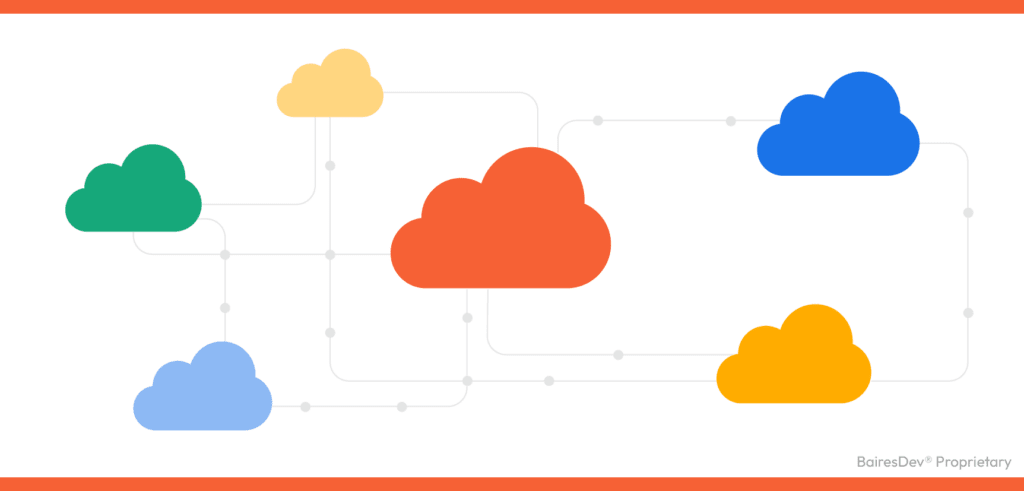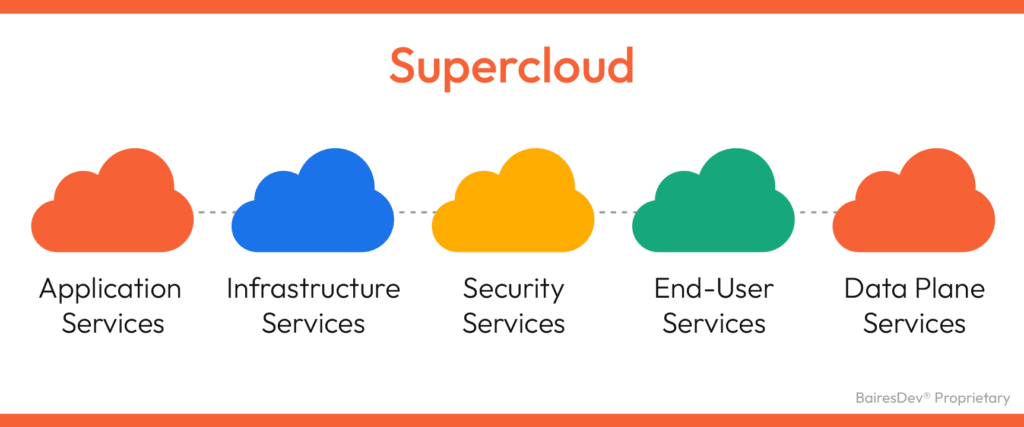According to Google, 41% of tech and business leaders plan on increasing their investment in cloud-based services due to the current economic climate. Techopedia claims that spending on public cloud services worldwide will likely grow by 21.7% before 2024 rings in. Finally, Gartner claims that public cloud service is up from $491 billion in 2022 to $597 billion in 2023.
Those numbers don’t lie. Cloud adoption is growing exponentially, and it’s only going to continue. But it’s not just public cloud consumption that’s rising. Businesses are using the cloud more and more, working with private, public, hybrid, and multi-cloud setups.
This dramatic rise has led to a new possibility, one being dubbed Supercloud. This term might be new to some, but to others, it’s a new take on distributed cloud infrastructure, and it’s primed to take the world by storm.
But what is this cloud chaos to which we refer?

Cloud Chaos is Coming For You
Just what is cloud chaos? Simply put, it’s when enterprise businesses suffer under the weight of growing undefined cloud architecture as they try to work with public and private clouds, as well as mixing in edge computing.
Remember when your company adopted its first piece of cloud technology? It was simple. Most likely, you were using it for file storage and sharing. And then your DevOps team realized how they could leverage the sheer power of the cloud to better deploy apps and services at scale.
Next thing you know, your company is using private, public, and hybrid clouds. At first, it might have been fairly straightforward to manage, but the deeper you dove into it, the more complicated it became. By now you might have discovered dealing with the numerous cloud services (all the while bonding them together with patchwork APIs) has become an almost impossible task. You throw more and more engineers at it, hoping to ease the burden of administration, but it only gets worse.
That’s cloud chaos, and without taking steps to avoid the problem, it’s inevitable.
That’s where Supercloud comes in.
Supercloud is Here to Ease Your Cloud Chaos
The term “Supercloud” was originally coined by a group of Cornell students, back in 2016. Their definition of the term was a cloud architecture that enables application migration as a service across different availability zones or providers.
Supercloud has caught the attention of businesses around the globe as the logical evolution of multi-cloud technology. As of now, there is no official definition of Supercloud (other than what the Cornell students came up with), and although some might see Supercloud as little more than a buzzword waiting for explanation, it’s actually more than that.
Consider Supercloud to be a collection of technologies that uses multicloud but completely abstracts end users away from the specifics of cloud providers. The idea is simple: You deploy all of your apps and services to the Supercloud, which would then be responsible for distributing them to your various clouds (such as Google Cloud, AWS, and Azure).

This would eliminate the need to cobble together APIs, or manage/maintain multiple cloud services individually. And because Supercloud is capable of spanning multiple providers, as well as public and private clouds, it could radically simplify the management of your at-scale apps and services.
Imagine the ability to easily migrate virtual machines, containers, and cloud-based services from any provider to any other with ease and to do so around the globe. Not only is that incredibly efficient but it also offers a considerable bump in reliability, as well as the ability to more easily serve customers and clients, no matter their location.
From Many to One
Think about it this way. If you currently depend on multiple clouds to service multiple regions, customers, and/or services, you’re probably having to deal with different cloud dashboards, complicated migration processes, complex code refactoring, and numerous teams of developers or third-party entities.
Supercloud promises to drastically reduce all of that. Instead, you might only have a single management dashboard that abstracts the more complex nature of multicloud setups such that the tasks of administering, migrating, and deploying can be done with a single UI.
That alone makes the idea of Supercloud exceptionally appealing.
Even better, Supercloud integrates IaaS, PaaS, and SaaS into one solution, which means the management and deployment of your services is even easier. Not only that, but you could save money by not having to employ engineers who specialize in those three platforms. Instead, you would only need developers and engineers who could focus on the job they were hired for, and they would not have to be jack-of-all-trades for everything cloud-related.
Tighten Your Focus with Supercloud
Another benefit of Supercloud is that you can optimize it to meet a specific need without having to repeat the efforts on multiple cloud instances. For example, the app or service you are about to deploy might place a high demand on latency, bandwidth, data recovery, query speed, cost-effectiveness, or high computing needs. With Supercloud, you could optimize for specific needs of deployment without having to manage that same optimization on multiple cloud instances.
It’s that efficient.
To add to Supercloud’s benefits, you can future-proof your business without hiring extra staff or creating custom software to integrate everything. Supercloud provides all the necessary tools and capabilities.
Interested in furthering your cloud development and integration? Learn more about our cloud computing services.
Avoid Vendor Lock-In
Another keen advantage of Supercloud is that it will help your company avoid vendor lock-in. At the moment, you might feel as if you can’t easily migrate from one provider to another. Using multiple cloud providers seamlessly is little more than a pipe dream for some businesses.
The very nature of Supercloud avoids vendor lock-in by making it easy to constantly shift between cloud providers without having to build custom APIs or interfaces to make it work (and then have to retool them when a company breaks the connection).
The Supercloud Caveat
This is where things get a bit tricky. Although the need for Supercloud couldn’t possibly be higher at the moment, it’s still mostly a concept. No one company has rolled out a Supercloud solution. Although the idea behind Supercloud might not be exactly in its infancy, nothing has come to fruition. You can’t reach out to a company and sign up for their Supercloud solution, because it doesn’t exist yet.
However, it would come as no surprise if multiple Supercloud solutions were made available in 2024. Supercloud is a much-needed technology, and once it arrives, it will change how companies leverage the cloud.






